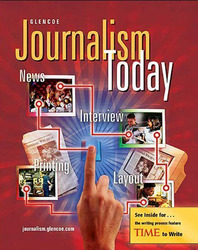Journalism TodayChapter 18:
Taking and Using Effective PhotographsActivity Lesson PlansIntroduction
In this activity students will visit the virtual exhibit Capture the Moment: The Pulitzer Prize Photographs, created by the Newseum: the Interactive Museum of News. This exhibit showcases the work of several Pulitzer Prize-winning photographers and provides audio commentary about each photo by its photographer and brief biographical information about each photographer. Students will answer one question per photo. Lesson Description
In this activity students will use the Internet to explore an online photojournalism exhibit at the Newseum: The Interactive Museum of News http://www.newseum.org/pulitzer/. Students will practice their listening skills by answering questions about each photo's audio commentary. Students will also learn new photography terminology and explore the importance of the still image. Instructional Objectives
- Students will become familiar with new photography terminology.
- Students will be able to practice their listening skills.
- Students will explore the importance of the still image and discover what makes a Pulitzer Prize photograph.
- Students will be able to effectively navigate a Web site.
Student Web Activity Answers
- Possible answer: Rosenthal says he stands for whoever was in the position to take the photograph at that moment. Rosenthal might mean that a photographer needs a little luck: you must be in the right place at the right time to get the best photograph.
- Possible answer: This is a picture of people crawling through the pontoon bridge's girders. The bridge crosses the river at Pyongyang, North Korea, and had been quickly constructed by the army engineers.
- Answer: "The lid is on" or "lid's on" means no more pictures can be taken.
- Answer: The camera captures the gunman in the bushes.
- Possible answer: Adams means that the gunman, a general in the South Vietnamese army, died a sort of societal death since, despite the actions of the man who is about to be shot. This photograph portrays the general as the aggressor, and some people condemned him for his actions.
- Possible answer: Lanker says that the strength of a still photograph lies in its ability to synthesize or concentrate a moment or event in life so that we may understand the significance of that moment or event.
- Answer: Since you cannot see his face, his posture makes him a sort of "everyman."
- Possible answer: Kelly says that he didn't see what happened in the frame of his camera when he shot this photo. Indeed, he had no idea that the suspect had briefly escaped from police custody until the photo was developed.
- Answer: Yes, Edmonds said the only bullet that didn't hit something went right over his head.
- Answer: The woman is holding helmets toward the reporters while telling them that the helmets were worn by the people responsible for the deaths in the Palestinian camps.
- Answer: Guzy thinks there's great power in a still photo because the image becomes etched in people's minds if they are moved or touched by it regardless of reason. Yes, this is a similar sentiment to Brian Lanker's thoughts regarding the still photo.
- Answer: Macor says that a "yield sign" is the only thing from the photo that is still there. Everything else had been removed.
- Answer: Zemlianichenko wanted to show the world what was happening in his country (Russia).
- Answer: Zemlianchenko says that this photo shows that Yeltsin was not just the Russian leader: he is also a "real man."
- Possible answer: After this photo ran, reports to Los Angeles's Department of Child and Family Services increased dramatically and remained at elevated levels for some time. The adult in this photograph was arrested, and the child was placed in foster care. Local government was examining how the DCFS could improve dealing with situations portrayed in the photograph.
- Answer: Senosi says five minutes passed before he reached the site in the photograph.
- Possible answer: The cut position is a side position. Walsh said that this was the only angle that would show President and Mrs. Clinton in the same frame close-up. Walsh felt that Mrs. Clinton was a significant part of the story; therefore, having the two in the frame at once was important.
- Possible answer: Answers may vary. For example, the juxtaposition of the baby and the barbed wire conveys the emotional effects of war.
GO TO STUDENT ACTIVITY  | 




